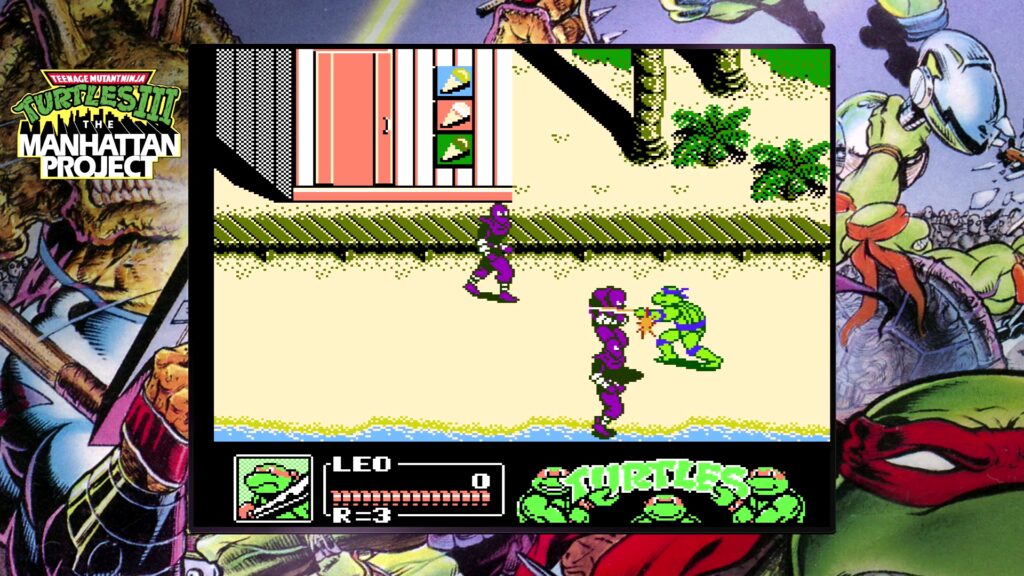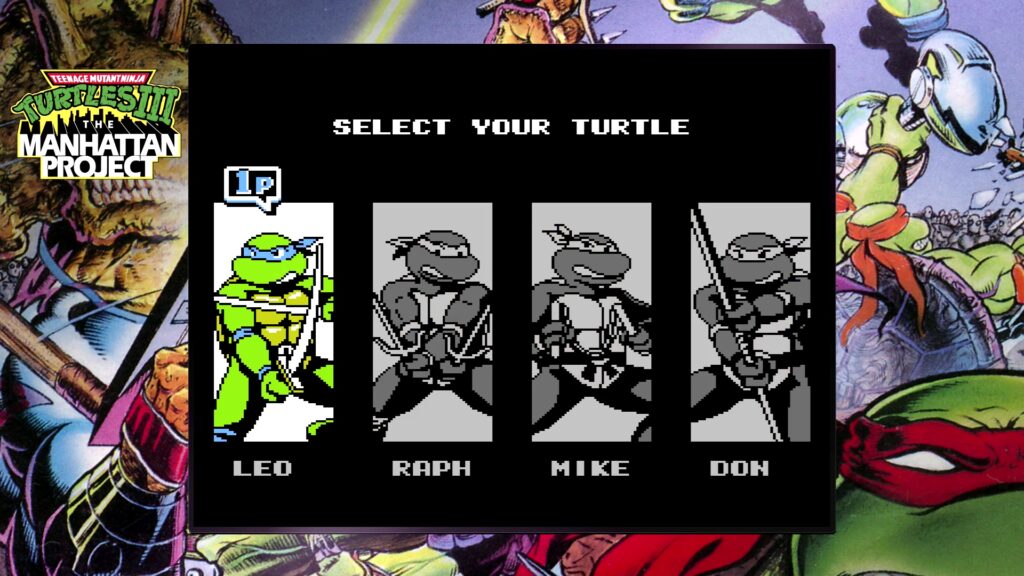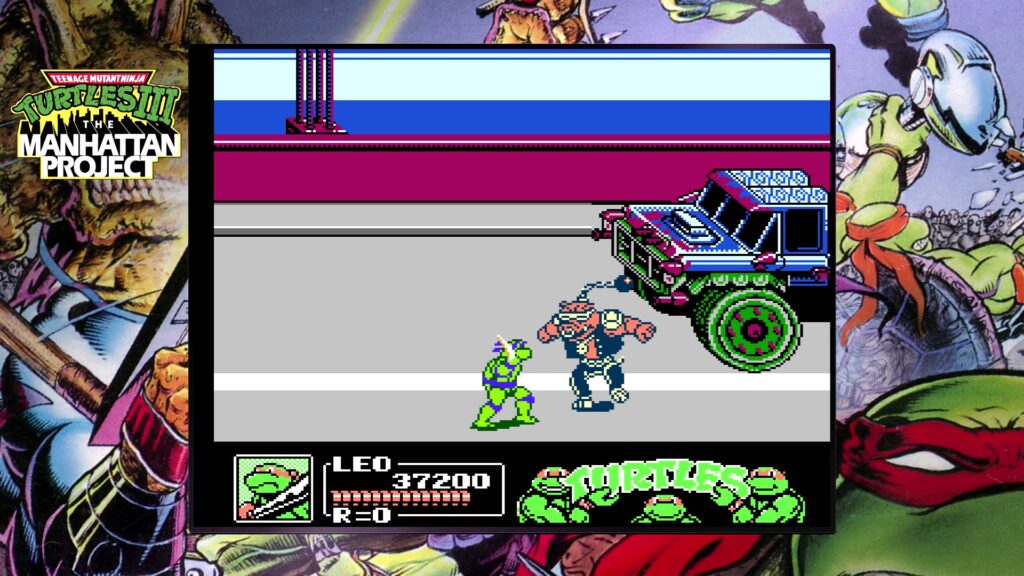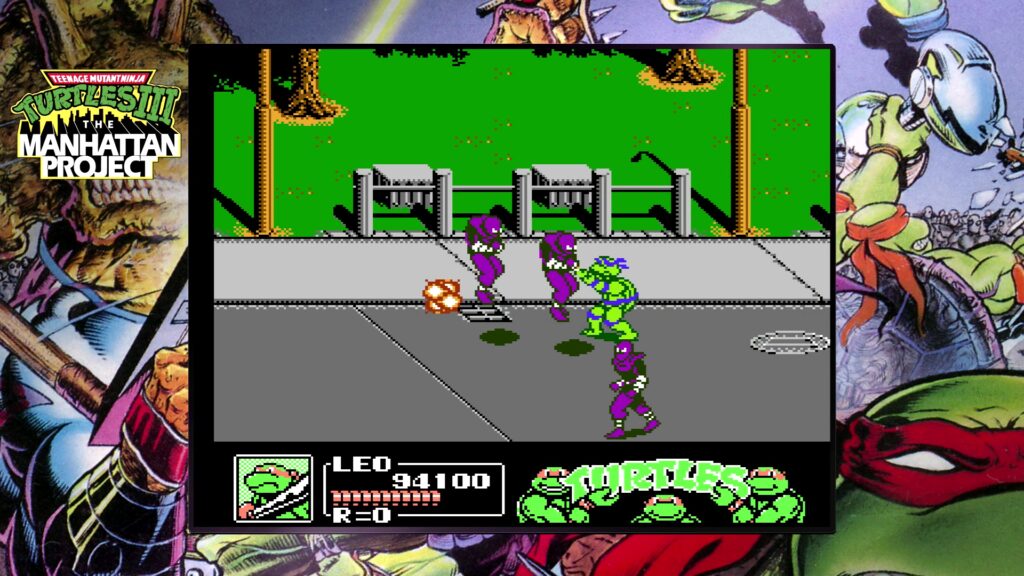Teenage Mutant Ninja Turtles III: The Manhattan Project is a top-tier NES beat ’em up
As we’ve previously discussed, the original Teenage Mutant Ninja Turtles arcade game by Konami is held up by many gamers as some sort of inviolable holy idol — the very pinnacle of classic late ’80s/early ’90s arcade beat ’em ups. And for a long time, I held a similar view. But the more time I spend with Teenage Mutant Ninja Turtles: The Cowabunga Collection, the more I feel like the games which followed that original arcade classic — like 1992’s Teenage Mutant Ninja Turtles III: The Manhattan Project for NES — actually outstrip that first game quite considerably in terms of gameplay.
I mean, it makes sense if you stop to think about it, really. The original Teenage Mutant Ninja Turtles arcade game came out before Capcom’s Final Fight, a game which many people consider to have really codified the specifics of what makes a good, satisfying beat ’em up. And as such, it really shouldn’t be all that surprising that later games in the same series were better able to refine their mechanics and structure to produce a more satisfying game.

But I suspect there’s always been an assumption that an 8-bit NES game couldn’t possibly live up to the glory of an arcade machine. More powerful hardware always makes for better games, right? Well, as we all know from the questionable desirability of today’s “next-gen” platforms, that absolutely isn’t true; a game that makes solid use of established hardware can often provide a superior experience to the latest and greatest tech, at least in terms of gameplay. Sure, it might not look quite as nice, but you can count on some nicely refined gameplay.
Such is the case with Teenage Mutant Ninja Turtles III: The Manhattan Project for NES. Sure, it doesn’t look as nice as the original arcade game — although it is one of the nicest looking games on the NES, particularly if you turn on Digital Eclipse’s slowdown and sprite flicker-removing enhancements in the Cowabunga Collection — but it plays beautifully. It’s satisfying but challenging, it has an impressive amount of depth in a genre often criticised for being a bit button-mashy, and it’s simply a great game for both solo players and pairs of friends.
In Teenage Mutant Ninja Turtles III: The Manhattan Project, the Turtles are holidaying in Florida when they learn that Shredder is, once again, causing mischief in New York. This time, for reasons that aren’t entirely clear, he’s lifted the entire island of Manhattan into the sky and kidnapped April O’Neil, seemingly for no other reason than to spite the Turtles. And as such, they need to make their way back to New York, kick Shredder repeatedly in the face, neck and testicles for the umpteenth time, and sort this mess out once and for all.

Like the other Turtles beat ’em ups, you can play as any of the Turtles. There’s a notable difference in Teenage Mutant Ninja Turtles III: The Manhattan Project, though — between lives, you can actually switch your playable character if you so desire. This means that if you’ve been finding a particular encounter challenging with one Turtle, you can see if the distinctive abilities of the others might make it a bit easier. And, given one of the main focuses of the gameplay in The Manhattan Project, this can often be quite helpful.
Each Turtle is simple to control. Much like the original arcade game, they have a basic attack combo and the ability to jump, as well as perform a flying kick if you attack while jumping. Notably, though, it’s also possible to jab and throw with each Turtle’s weapon by holding down on the directional pad and the attack button; this is a move that was present in the original arcade game but absent from the NES port.
While it was, for the most part, simply a fun move to perform in the original Turtles arcade game, in The Manhattan Project it’s absolutely essential to success. The “jab” part of the move has greater reach than each of the Turtles’ basic attack combo, you see, which means you can stand a little further back from enemies than you would otherwise be able to — and since so many of the foes in The Manhattan Project have the ability to perform powerful, unavoidable attacks if you get too close to them, it becomes extremely important to find a means of keeping your distance.

Until you figure this out, Teenage Mutant Ninja Turtles III: The Manhattan Project can feel a bit frustrating. While the basic Foot Clan soldiers are easy enough to dispatch, more powerful enemies and bosses can feel like they’re almost entirely unapproachable; you can’t even make use of the old beat ’em up standard of approaching them diagonally and throwing them, since like prior Turtles beat ’em ups, there’s no grapple-and-throw mechanic in The Manhattan Project.
But then you’ll discover the wonder of poking enemies from just outside their effective attack range, and the entire game changes its feel considerably. It begins to place much less emphasis on hitstunning enemies with combos like in beat ’em ups that follow the Final Fight mould, and instead it highlights the importance of space management and an understanding of reach. These are always considerations in good beat ’em ups, but they’re absolutely critical in Teenage Mutant Ninja Turtles III: The Manhattan Project — and that gives the game an enjoyably technical feel, where each cleared encounter feels like a genuine victory.
The encounters are enjoyably varied, too. Much like in NES versions of other classic beat ’em up series — Technos Japan’s Double Dragon series being one of the most notable — the inherent limitations of the platform mean that you’ll never face more than four enemies simultaneously, and all of those enemies will be of the same type. But there are so many different types of enemy in the game that the encounters constantly feel interesting — and the relatively low amount of health the basic Foot Clan soldiers have mean that the game is almost constantly moving forward rather than getting bogged down.

Sure, there are sequences where you have to battle more powerful foes, but these are punctuated by more pacy segments that keep you moving along, so at no point does the game feel like a slog. The interesting level design is also more enjoyable than the NES port of the arcade game, since rather than simply repeating sequences to artificially extend the length of levels, there’s a much stronger sense of actually going on a journey through each location, with varied scenery and obstacles to negotiate alongside the foes to fend off.
I’m genuinely impressed with Teenage Mutant Ninja Turtles III: The Manhattan Project. It represents a solid evolution of the Turtles beat ’em up formula, and is a prime example of a late-era NES game that looks, sounds and plays great. If you, like me, have previously ignored it in favour of the arcade game on the basis that an 8-bit console game couldn’t possibly be as good, then take a bit of time to educate yourself. You will almost certainly be very pleasantly surprised.
Teenage Mutant Ninja Turtles: The Cowabunga Collection is available now for PC via Steam, physically and digitally for Switch, physically and digitally for PS5, physically and digitally for PS4, and physically and digitally for Xbox One/Series blahdepoop.
Join The Discussion
Rice Digital Discord
Rice Digital Twitter
Rice Digital Facebook
Or write us a letter for the Rice Digital Friday Letters Page by clicking here!
Disclosure: Some links in this article may be affiliate links, which means we may earn a small commission if you make a purchase after clicking on them. This is at no additional cost to you and helps support Rice Digital!
- Letter from the Editor: passing the torch - June 30, 2023
- Super Woden GP 2 is looking promising - June 30, 2023
- Inti Creates is making a 32 bit-style Love Live action platformer - June 26, 2023







